Product Life Cycle Assessment of Washing Machines: A Detailed Report
VerifiedAdded on 2023/04/21
|22
|4030
|211
Report
AI Summary
This report presents a streamlined life cycle assessment (SLCA) of washing machines, aiming to evaluate their environmental impact and propose improvements. It begins with an introduction to LCA and SLCA methodologies, highlighting the benefits of SLCA in terms of cost and time efficiency. The baseline study defines the scope and system boundaries, examining raw material extraction, manufacturing processes, and end-of-life considerations. The use phase, particularly water and energy consumption, is identified as a significant contributor to environmental impact, along with the effects of detergent usage. The report then proposes several design improvements, including water recycling, rainwater harvesting, RFID technology for optimized washing, NFC for remote diagnostics, and AC power metering for user awareness. Finally, the report touches on sustainability issues, implementation feasibility, and potential barriers, concluding with a summary of findings and recommendations for future work. The document is available on Desklib, where students can find similar solved assignments and study resources.
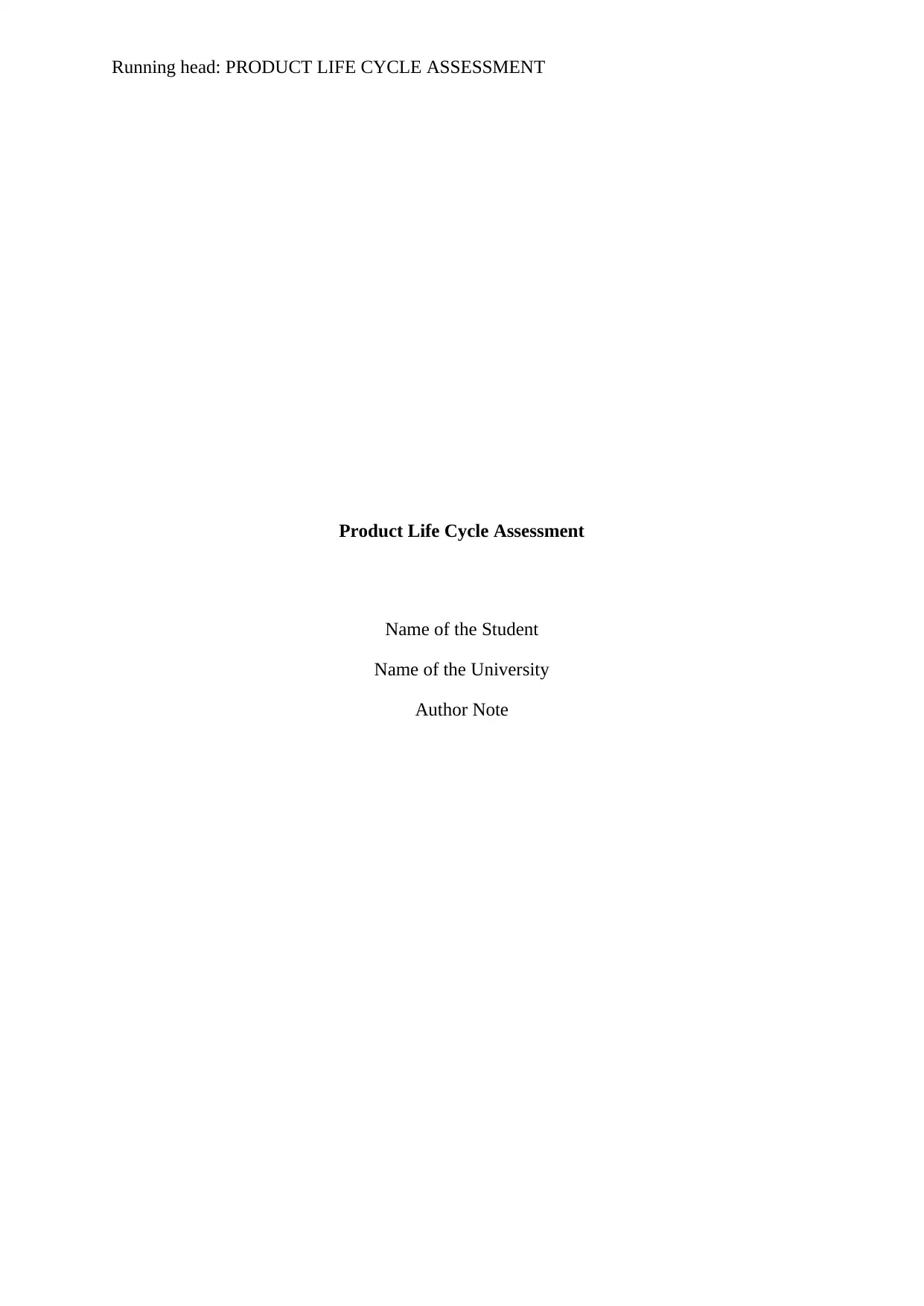
Running head: PRODUCT LIFE CYCLE ASSESSMENT
Product Life Cycle Assessment
Name of the Student
Name of the University
Author Note
Product Life Cycle Assessment
Name of the Student
Name of the University
Author Note
Paraphrase This Document
Need a fresh take? Get an instant paraphrase of this document with our AI Paraphraser
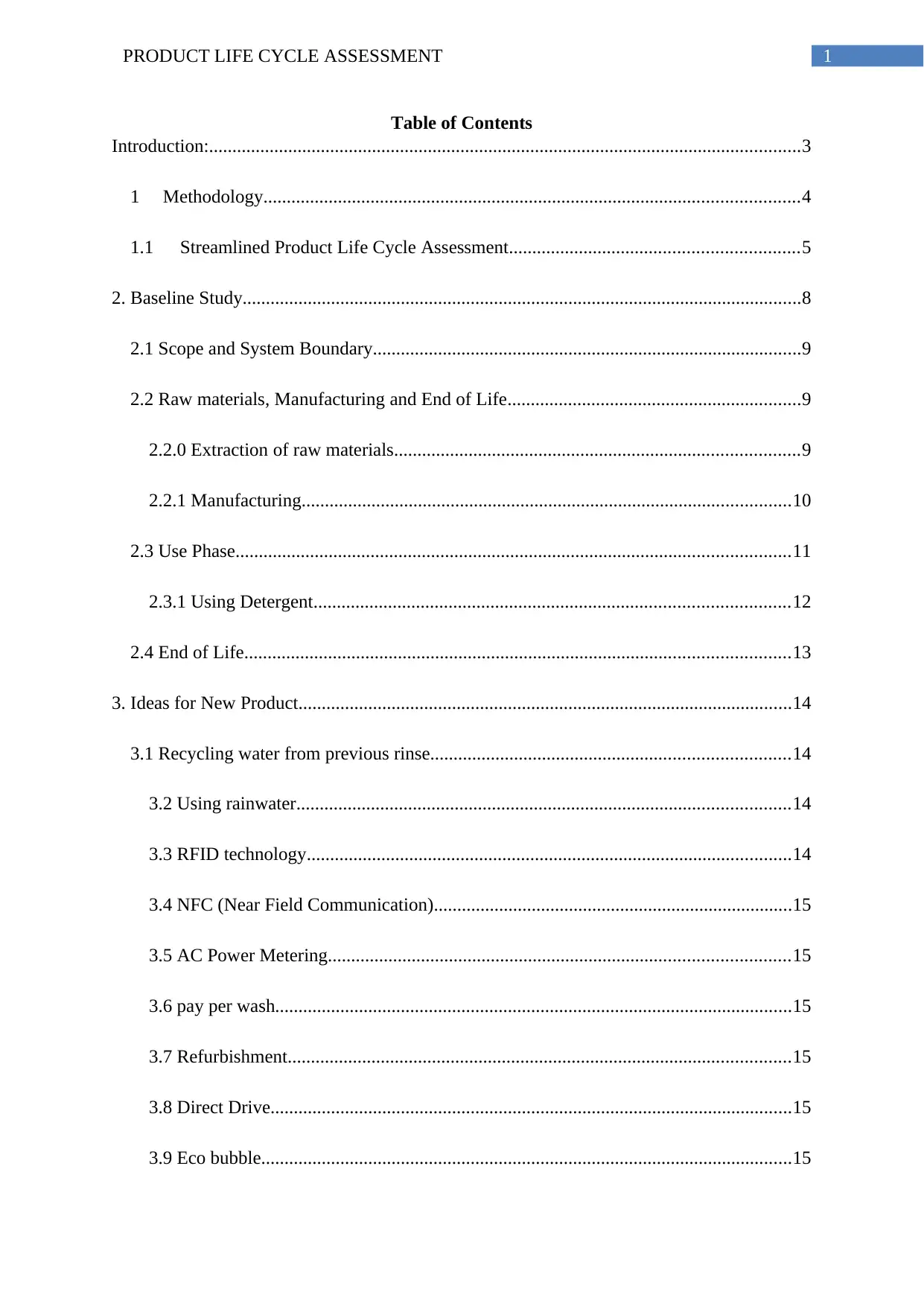
1PRODUCT LIFE CYCLE ASSESSMENT
Table of Contents
Introduction:...............................................................................................................................3
1 Methodology...................................................................................................................4
1.1 Streamlined Product Life Cycle Assessment..............................................................5
2. Baseline Study........................................................................................................................8
2.1 Scope and System Boundary............................................................................................9
2.2 Raw materials, Manufacturing and End of Life...............................................................9
2.2.0 Extraction of raw materials.......................................................................................9
2.2.1 Manufacturing.........................................................................................................10
2.3 Use Phase.......................................................................................................................11
2.3.1 Using Detergent......................................................................................................12
2.4 End of Life.....................................................................................................................13
3. Ideas for New Product..........................................................................................................14
3.1 Recycling water from previous rinse.............................................................................14
3.2 Using rainwater..........................................................................................................14
3.3 RFID technology........................................................................................................14
3.4 NFC (Near Field Communication).............................................................................15
3.5 AC Power Metering...................................................................................................15
3.6 pay per wash...............................................................................................................15
3.7 Refurbishment............................................................................................................15
3.8 Direct Drive................................................................................................................15
3.9 Eco bubble..................................................................................................................15
Table of Contents
Introduction:...............................................................................................................................3
1 Methodology...................................................................................................................4
1.1 Streamlined Product Life Cycle Assessment..............................................................5
2. Baseline Study........................................................................................................................8
2.1 Scope and System Boundary............................................................................................9
2.2 Raw materials, Manufacturing and End of Life...............................................................9
2.2.0 Extraction of raw materials.......................................................................................9
2.2.1 Manufacturing.........................................................................................................10
2.3 Use Phase.......................................................................................................................11
2.3.1 Using Detergent......................................................................................................12
2.4 End of Life.....................................................................................................................13
3. Ideas for New Product..........................................................................................................14
3.1 Recycling water from previous rinse.............................................................................14
3.2 Using rainwater..........................................................................................................14
3.3 RFID technology........................................................................................................14
3.4 NFC (Near Field Communication).............................................................................15
3.5 AC Power Metering...................................................................................................15
3.6 pay per wash...............................................................................................................15
3.7 Refurbishment............................................................................................................15
3.8 Direct Drive................................................................................................................15
3.9 Eco bubble..................................................................................................................15
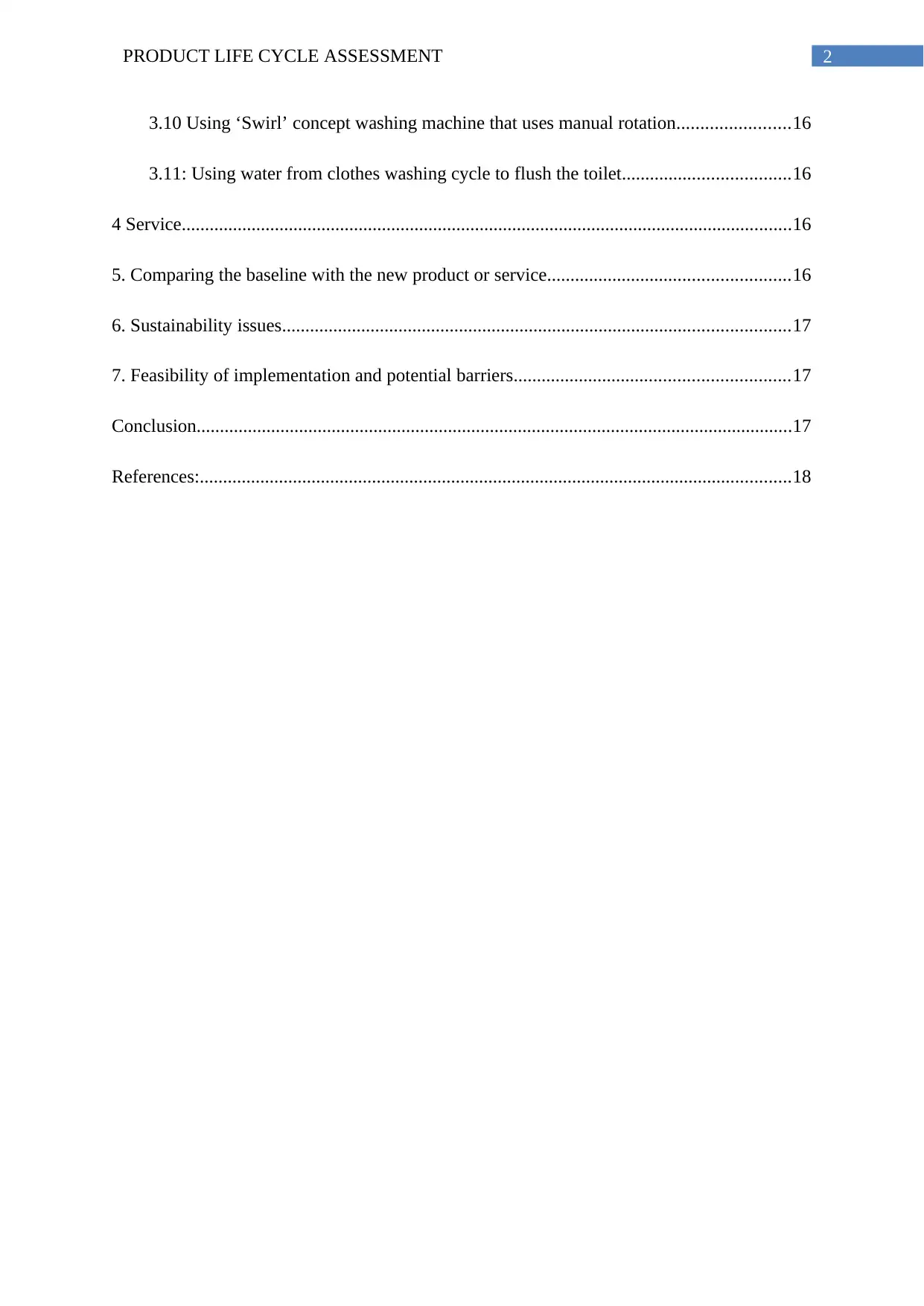
2PRODUCT LIFE CYCLE ASSESSMENT
3.10 Using ‘Swirl’ concept washing machine that uses manual rotation........................16
3.11: Using water from clothes washing cycle to flush the toilet....................................16
4 Service...................................................................................................................................16
5. Comparing the baseline with the new product or service....................................................16
6. Sustainability issues.............................................................................................................17
7. Feasibility of implementation and potential barriers...........................................................17
Conclusion................................................................................................................................17
References:...............................................................................................................................18
3.10 Using ‘Swirl’ concept washing machine that uses manual rotation........................16
3.11: Using water from clothes washing cycle to flush the toilet....................................16
4 Service...................................................................................................................................16
5. Comparing the baseline with the new product or service....................................................16
6. Sustainability issues.............................................................................................................17
7. Feasibility of implementation and potential barriers...........................................................17
Conclusion................................................................................................................................17
References:...............................................................................................................................18
⊘ This is a preview!⊘
Do you want full access?
Subscribe today to unlock all pages.

Trusted by 1+ million students worldwide
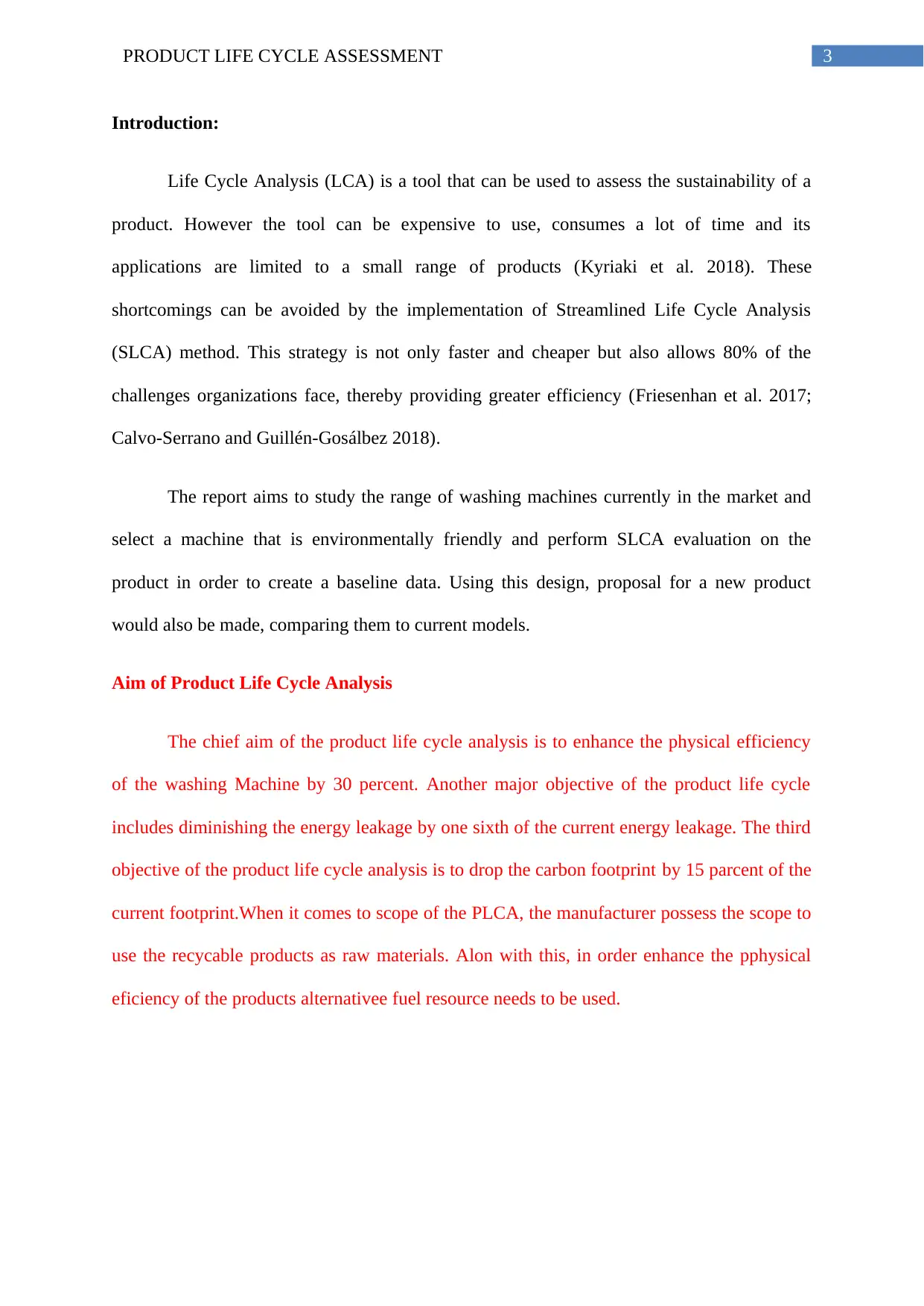
3PRODUCT LIFE CYCLE ASSESSMENT
Introduction:
Life Cycle Analysis (LCA) is a tool that can be used to assess the sustainability of a
product. However the tool can be expensive to use, consumes a lot of time and its
applications are limited to a small range of products (Kyriaki et al. 2018). These
shortcomings can be avoided by the implementation of Streamlined Life Cycle Analysis
(SLCA) method. This strategy is not only faster and cheaper but also allows 80% of the
challenges organizations face, thereby providing greater efficiency (Friesenhan et al. 2017;
Calvo-Serrano and Guillén-Gosálbez 2018).
The report aims to study the range of washing machines currently in the market and
select a machine that is environmentally friendly and perform SLCA evaluation on the
product in order to create a baseline data. Using this design, proposal for a new product
would also be made, comparing them to current models.
Aim of Product Life Cycle Analysis
The chief aim of the product life cycle analysis is to enhance the physical efficiency
of the washing Machine by 30 percent. Another major objective of the product life cycle
includes diminishing the energy leakage by one sixth of the current energy leakage. The third
objective of the product life cycle analysis is to drop the carbon footprint by 15 parcent of the
current footprint.When it comes to scope of the PLCA, the manufacturer possess the scope to
use the recycable products as raw materials. Alon with this, in order enhance the pphysical
eficiency of the products alternativee fuel resource needs to be used.
Introduction:
Life Cycle Analysis (LCA) is a tool that can be used to assess the sustainability of a
product. However the tool can be expensive to use, consumes a lot of time and its
applications are limited to a small range of products (Kyriaki et al. 2018). These
shortcomings can be avoided by the implementation of Streamlined Life Cycle Analysis
(SLCA) method. This strategy is not only faster and cheaper but also allows 80% of the
challenges organizations face, thereby providing greater efficiency (Friesenhan et al. 2017;
Calvo-Serrano and Guillén-Gosálbez 2018).
The report aims to study the range of washing machines currently in the market and
select a machine that is environmentally friendly and perform SLCA evaluation on the
product in order to create a baseline data. Using this design, proposal for a new product
would also be made, comparing them to current models.
Aim of Product Life Cycle Analysis
The chief aim of the product life cycle analysis is to enhance the physical efficiency
of the washing Machine by 30 percent. Another major objective of the product life cycle
includes diminishing the energy leakage by one sixth of the current energy leakage. The third
objective of the product life cycle analysis is to drop the carbon footprint by 15 parcent of the
current footprint.When it comes to scope of the PLCA, the manufacturer possess the scope to
use the recycable products as raw materials. Alon with this, in order enhance the pphysical
eficiency of the products alternativee fuel resource needs to be used.
Paraphrase This Document
Need a fresh take? Get an instant paraphrase of this document with our AI Paraphraser
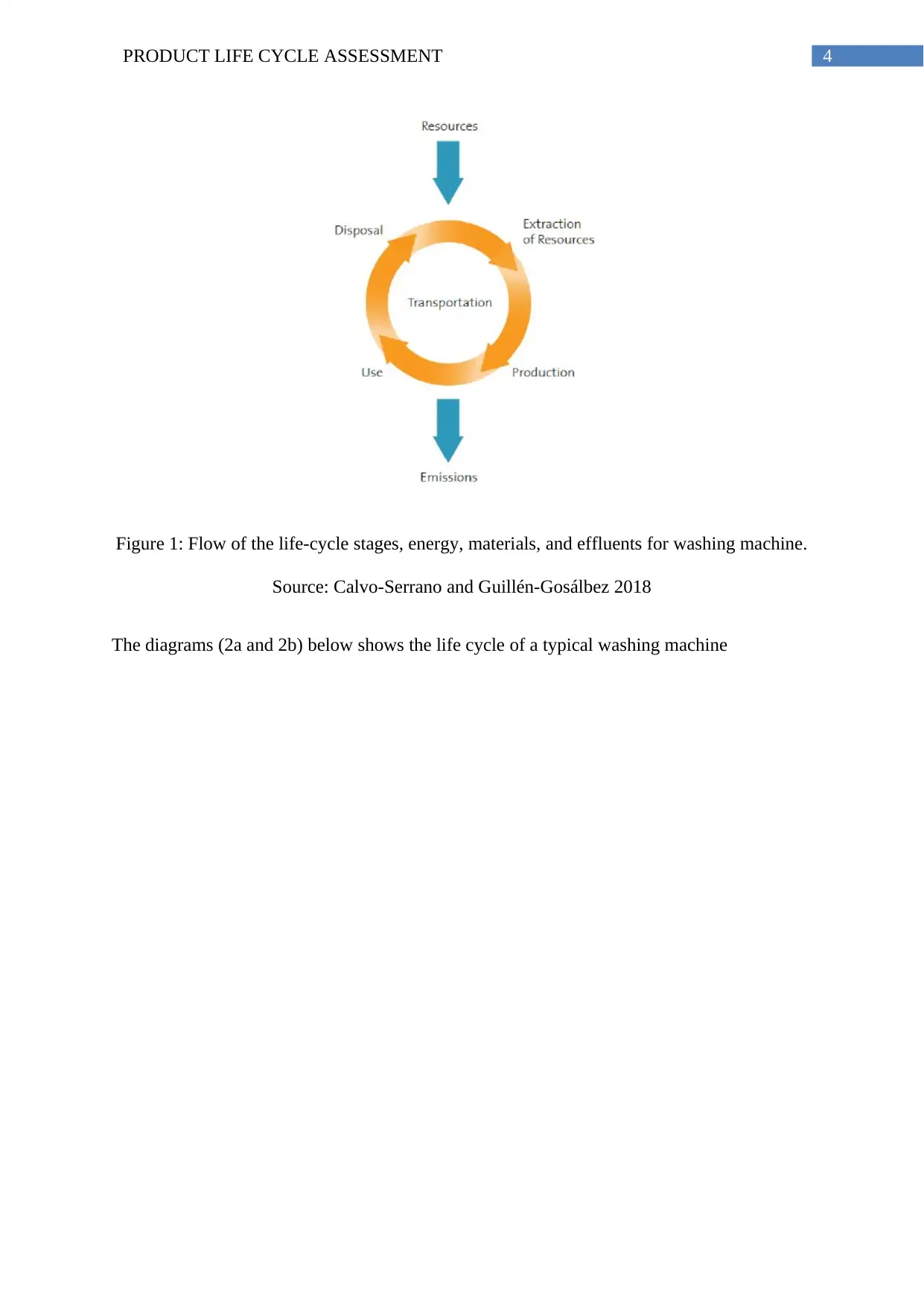
4PRODUCT LIFE CYCLE ASSESSMENT
Figure 1: Flow of the life-cycle stages, energy, materials, and effluents for washing machine.
Source: Calvo-Serrano and Guillén-Gosálbez 2018
The diagrams (2a and 2b) below shows the life cycle of a typical washing machine
Figure 1: Flow of the life-cycle stages, energy, materials, and effluents for washing machine.
Source: Calvo-Serrano and Guillén-Gosálbez 2018
The diagrams (2a and 2b) below shows the life cycle of a typical washing machine
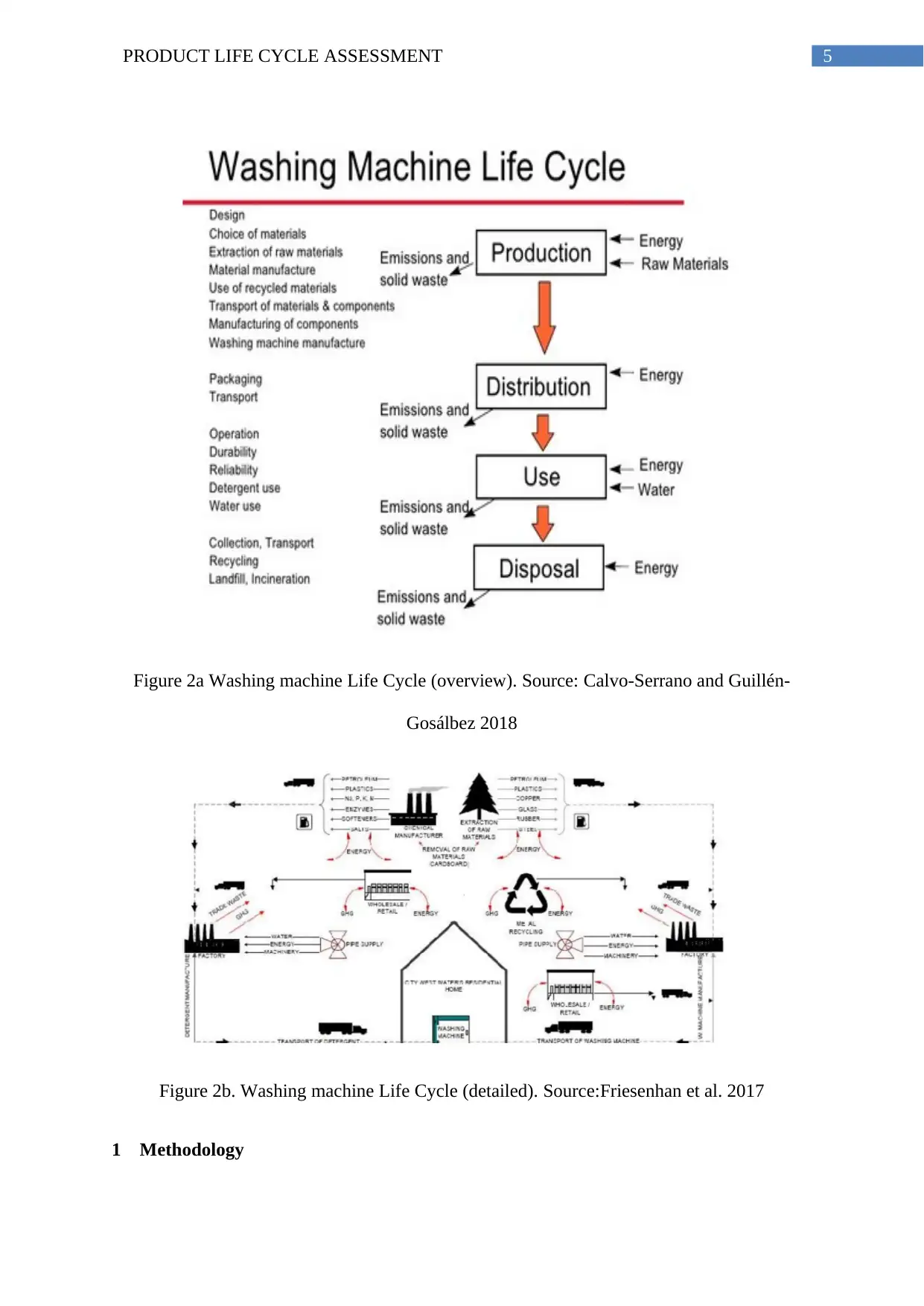
5PRODUCT LIFE CYCLE ASSESSMENT
Figure 2a Washing machine Life Cycle (overview). Source: Calvo-Serrano and Guillén-
Gosálbez 2018
Figure 2b. Washing machine Life Cycle (detailed). Source:Friesenhan et al. 2017
1 Methodology
Figure 2a Washing machine Life Cycle (overview). Source: Calvo-Serrano and Guillén-
Gosálbez 2018
Figure 2b. Washing machine Life Cycle (detailed). Source:Friesenhan et al. 2017
1 Methodology
⊘ This is a preview!⊘
Do you want full access?
Subscribe today to unlock all pages.

Trusted by 1+ million students worldwide
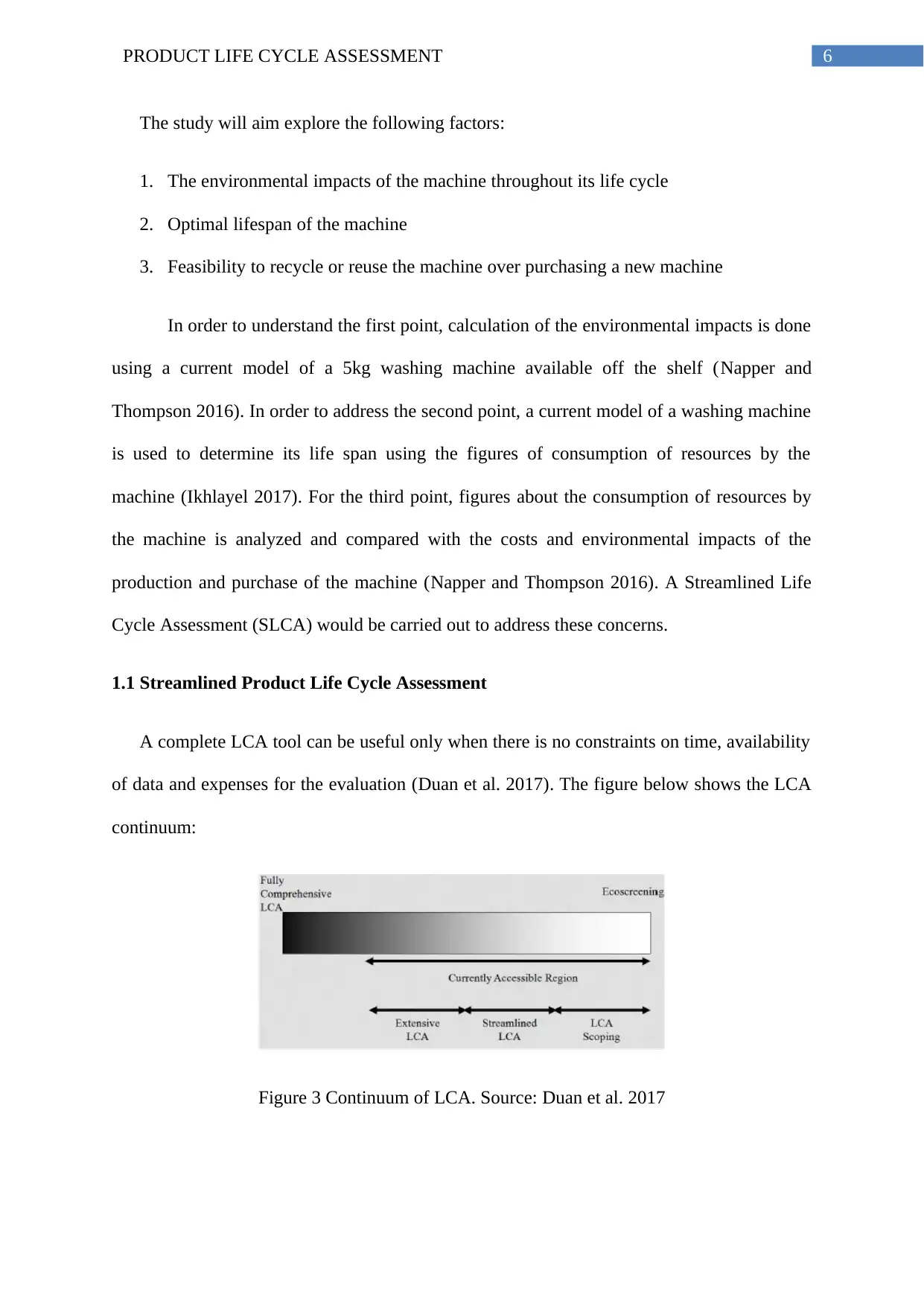
6PRODUCT LIFE CYCLE ASSESSMENT
The study will aim explore the following factors:
1. The environmental impacts of the machine throughout its life cycle
2. Optimal lifespan of the machine
3. Feasibility to recycle or reuse the machine over purchasing a new machine
In order to understand the first point, calculation of the environmental impacts is done
using a current model of a 5kg washing machine available off the shelf (Napper and
Thompson 2016). In order to address the second point, a current model of a washing machine
is used to determine its life span using the figures of consumption of resources by the
machine (Ikhlayel 2017). For the third point, figures about the consumption of resources by
the machine is analyzed and compared with the costs and environmental impacts of the
production and purchase of the machine (Napper and Thompson 2016). A Streamlined Life
Cycle Assessment (SLCA) would be carried out to address these concerns.
1.1 Streamlined Product Life Cycle Assessment
A complete LCA tool can be useful only when there is no constraints on time, availability
of data and expenses for the evaluation (Duan et al. 2017). The figure below shows the LCA
continuum:
Figure 3 Continuum of LCA. Source: Duan et al. 2017
The study will aim explore the following factors:
1. The environmental impacts of the machine throughout its life cycle
2. Optimal lifespan of the machine
3. Feasibility to recycle or reuse the machine over purchasing a new machine
In order to understand the first point, calculation of the environmental impacts is done
using a current model of a 5kg washing machine available off the shelf (Napper and
Thompson 2016). In order to address the second point, a current model of a washing machine
is used to determine its life span using the figures of consumption of resources by the
machine (Ikhlayel 2017). For the third point, figures about the consumption of resources by
the machine is analyzed and compared with the costs and environmental impacts of the
production and purchase of the machine (Napper and Thompson 2016). A Streamlined Life
Cycle Assessment (SLCA) would be carried out to address these concerns.
1.1 Streamlined Product Life Cycle Assessment
A complete LCA tool can be useful only when there is no constraints on time, availability
of data and expenses for the evaluation (Duan et al. 2017). The figure below shows the LCA
continuum:
Figure 3 Continuum of LCA. Source: Duan et al. 2017
Paraphrase This Document
Need a fresh take? Get an instant paraphrase of this document with our AI Paraphraser
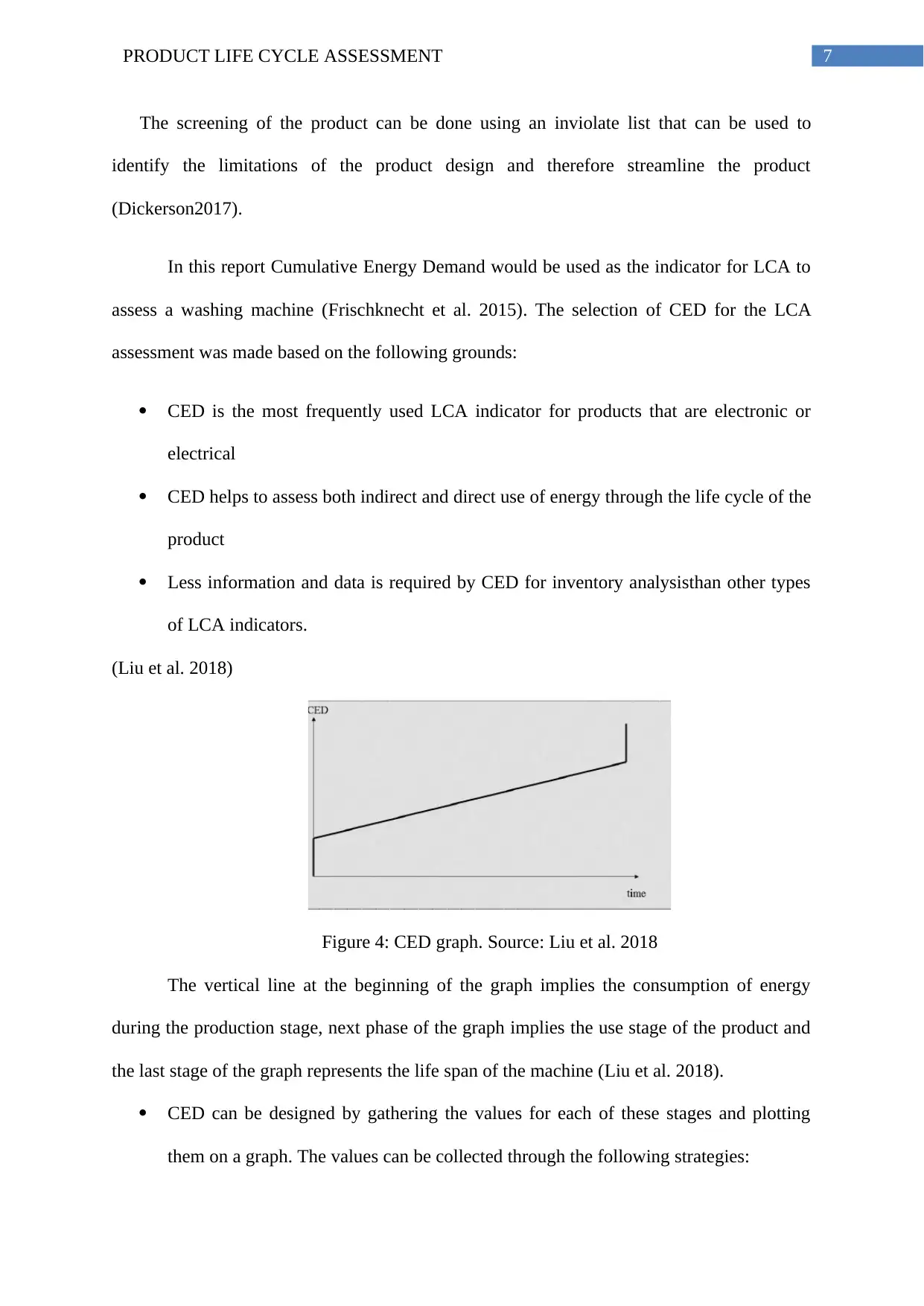
7PRODUCT LIFE CYCLE ASSESSMENT
The screening of the product can be done using an inviolate list that can be used to
identify the limitations of the product design and therefore streamline the product
(Dickerson2017).
In this report Cumulative Energy Demand would be used as the indicator for LCA to
assess a washing machine (Frischknecht et al. 2015). The selection of CED for the LCA
assessment was made based on the following grounds:
CED is the most frequently used LCA indicator for products that are electronic or
electrical
CED helps to assess both indirect and direct use of energy through the life cycle of the
product
Less information and data is required by CED for inventory analysisthan other types
of LCA indicators.
(Liu et al. 2018)
Figure 4: CED graph. Source: Liu et al. 2018
The vertical line at the beginning of the graph implies the consumption of energy
during the production stage, next phase of the graph implies the use stage of the product and
the last stage of the graph represents the life span of the machine (Liu et al. 2018).
CED can be designed by gathering the values for each of these stages and plotting
them on a graph. The values can be collected through the following strategies:
The screening of the product can be done using an inviolate list that can be used to
identify the limitations of the product design and therefore streamline the product
(Dickerson2017).
In this report Cumulative Energy Demand would be used as the indicator for LCA to
assess a washing machine (Frischknecht et al. 2015). The selection of CED for the LCA
assessment was made based on the following grounds:
CED is the most frequently used LCA indicator for products that are electronic or
electrical
CED helps to assess both indirect and direct use of energy through the life cycle of the
product
Less information and data is required by CED for inventory analysisthan other types
of LCA indicators.
(Liu et al. 2018)
Figure 4: CED graph. Source: Liu et al. 2018
The vertical line at the beginning of the graph implies the consumption of energy
during the production stage, next phase of the graph implies the use stage of the product and
the last stage of the graph represents the life span of the machine (Liu et al. 2018).
CED can be designed by gathering the values for each of these stages and plotting
them on a graph. The values can be collected through the following strategies:
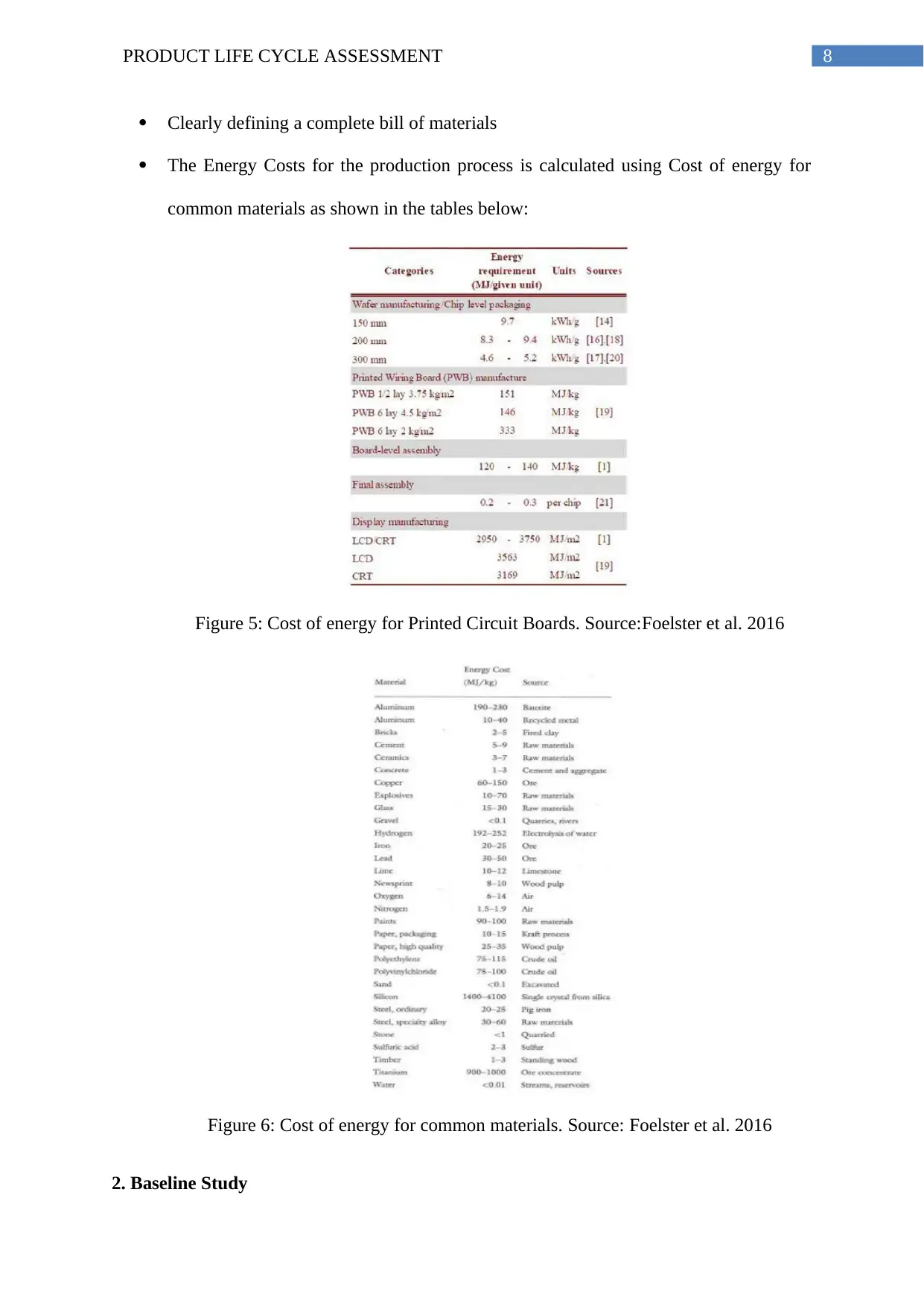
8PRODUCT LIFE CYCLE ASSESSMENT
Clearly defining a complete bill of materials
The Energy Costs for the production process is calculated using Cost of energy for
common materials as shown in the tables below:
Figure 5: Cost of energy for Printed Circuit Boards. Source:Foelster et al. 2016
Figure 6: Cost of energy for common materials. Source: Foelster et al. 2016
2. Baseline Study
Clearly defining a complete bill of materials
The Energy Costs for the production process is calculated using Cost of energy for
common materials as shown in the tables below:
Figure 5: Cost of energy for Printed Circuit Boards. Source:Foelster et al. 2016
Figure 6: Cost of energy for common materials. Source: Foelster et al. 2016
2. Baseline Study
⊘ This is a preview!⊘
Do you want full access?
Subscribe today to unlock all pages.

Trusted by 1+ million students worldwide
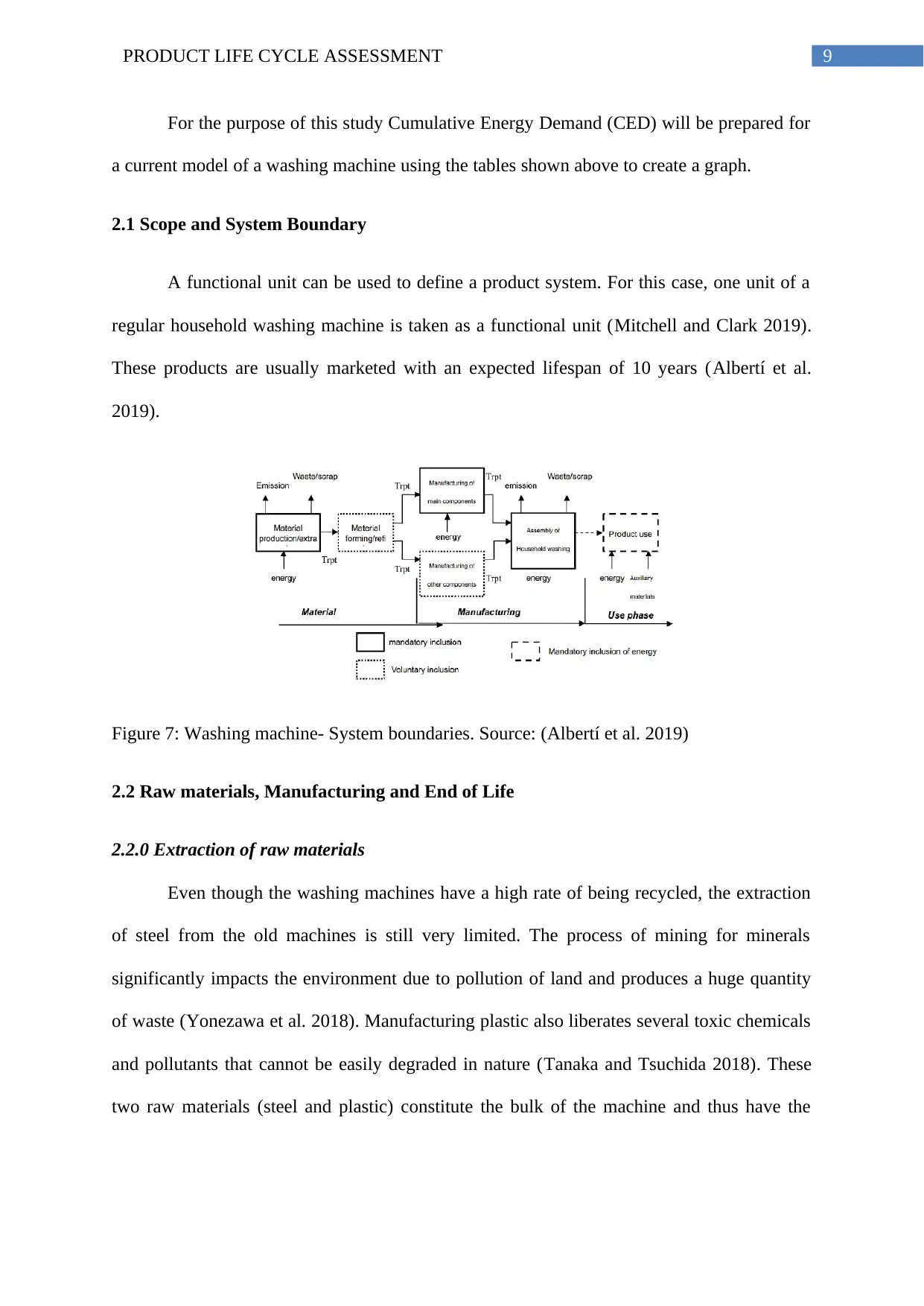
9PRODUCT LIFE CYCLE ASSESSMENT
For the purpose of this study Cumulative Energy Demand (CED) will be prepared for
a current model of a washing machine using the tables shown above to create a graph.
2.1 Scope and System Boundary
A functional unit can be used to define a product system. For this case, one unit of a
regular household washing machine is taken as a functional unit (Mitchell and Clark 2019).
These products are usually marketed with an expected lifespan of 10 years (Albertí et al.
2019).
Figure 7: Washing machine- System boundaries. Source: (Albertí et al. 2019)
2.2 Raw materials, Manufacturing and End of Life
2.2.0 Extraction of raw materials
Even though the washing machines have a high rate of being recycled, the extraction
of steel from the old machines is still very limited. The process of mining for minerals
significantly impacts the environment due to pollution of land and produces a huge quantity
of waste (Yonezawa et al. 2018). Manufacturing plastic also liberates several toxic chemicals
and pollutants that cannot be easily degraded in nature (Tanaka and Tsuchida 2018). These
two raw materials (steel and plastic) constitute the bulk of the machine and thus have the
For the purpose of this study Cumulative Energy Demand (CED) will be prepared for
a current model of a washing machine using the tables shown above to create a graph.
2.1 Scope and System Boundary
A functional unit can be used to define a product system. For this case, one unit of a
regular household washing machine is taken as a functional unit (Mitchell and Clark 2019).
These products are usually marketed with an expected lifespan of 10 years (Albertí et al.
2019).
Figure 7: Washing machine- System boundaries. Source: (Albertí et al. 2019)
2.2 Raw materials, Manufacturing and End of Life
2.2.0 Extraction of raw materials
Even though the washing machines have a high rate of being recycled, the extraction
of steel from the old machines is still very limited. The process of mining for minerals
significantly impacts the environment due to pollution of land and produces a huge quantity
of waste (Yonezawa et al. 2018). Manufacturing plastic also liberates several toxic chemicals
and pollutants that cannot be easily degraded in nature (Tanaka and Tsuchida 2018). These
two raw materials (steel and plastic) constitute the bulk of the machine and thus have the
Paraphrase This Document
Need a fresh take? Get an instant paraphrase of this document with our AI Paraphraser
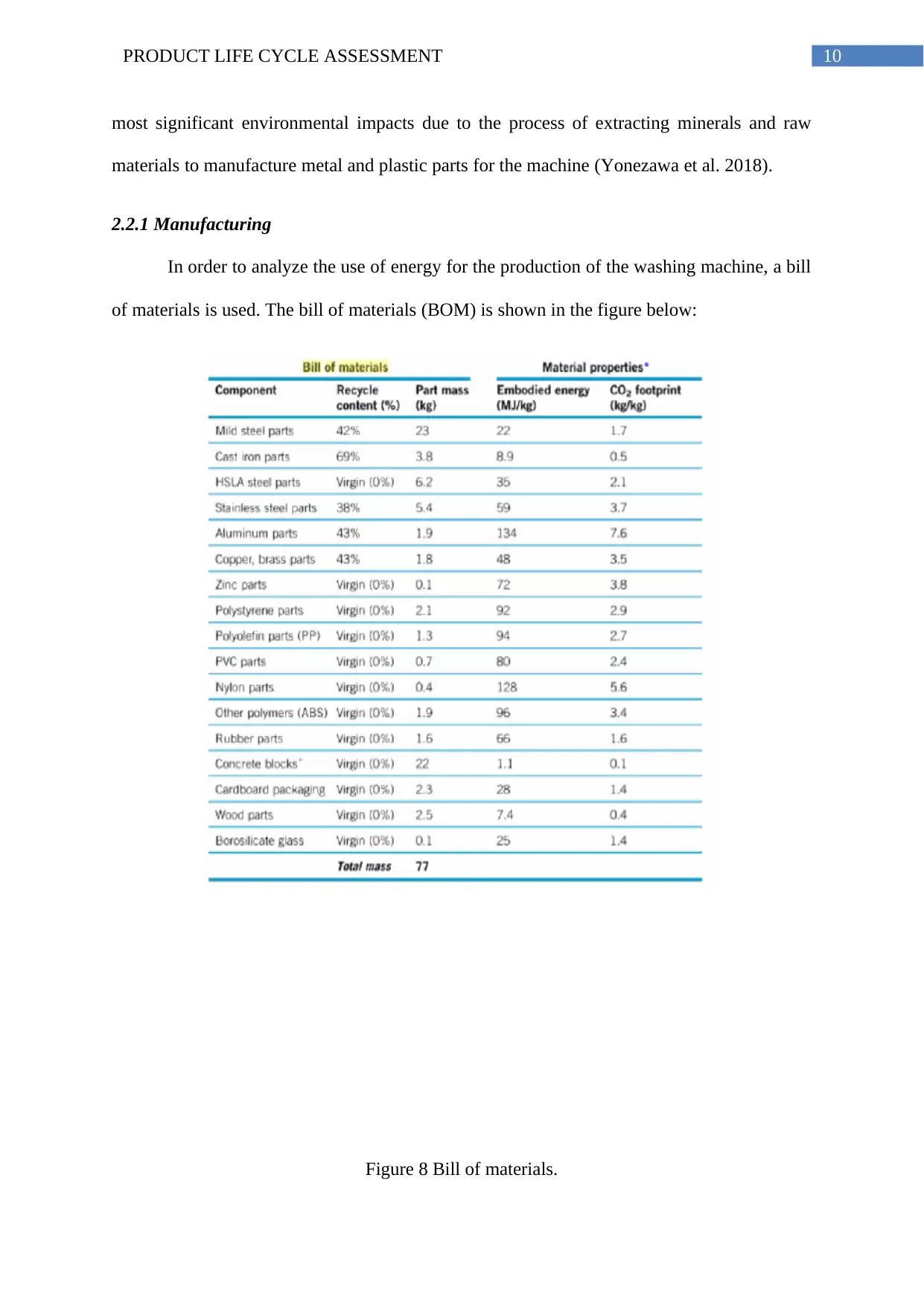
10PRODUCT LIFE CYCLE ASSESSMENT
most significant environmental impacts due to the process of extracting minerals and raw
materials to manufacture metal and plastic parts for the machine (Yonezawa et al. 2018).
2.2.1 Manufacturing
In order to analyze the use of energy for the production of the washing machine, a bill
of materials is used. The bill of materials (BOM) is shown in the figure below:
Figure 8 Bill of materials.
most significant environmental impacts due to the process of extracting minerals and raw
materials to manufacture metal and plastic parts for the machine (Yonezawa et al. 2018).
2.2.1 Manufacturing
In order to analyze the use of energy for the production of the washing machine, a bill
of materials is used. The bill of materials (BOM) is shown in the figure below:
Figure 8 Bill of materials.

11PRODUCT LIFE CYCLE ASSESSMENT
From the figure above, it can be clearly understood that most of the raw materials
required to manufacture one unit of a washing machine are metal parts, most of which can be
recycled or reused. An overall consumption of 996 Mega Joules of energy can be calculated
based on the values on the table above. After including the energy costs of manufacturing
these parts, the overall energy cost comes to 1008 mega Joules or 280 Kilo Watt Hour.
2.3 Use Phase
This stage of the washing machine consumes the maximum amount of energy. This is
primarily influenced by the frequency at which the machine is operated and the detergents
used for washing purposes (Tanaka and Tsuchida 2018). The impacts of the use phase are
mainly caused by the following factors:
Use of water (92% impact on life cycle)
Use of energy (60% impact in life cycle)
Global warming (73% impact on life cycle)
Depletion of fossil fuels (62% impact on life cycle)
(Engle et al. 2018)
The rinsing cycle uses 25 liters of water resulting in an overall requirement of 35
liters of water. For average houses that uses 200 washes every year, almost 7000 liters of
water is used. The annual use of electricity is approximately 3055 kilo watt hours or 11000
mega joules. In an average lifespan of 10 years, almost 2000 washes can be made, using
about 70,000 liters of water and 80000 mega joules or 2222 kilowatt hour of electricity.
Fossil fuels are also needed for the operations of the machine that causes emission of 80kg of
greenhouse gases such as carbon dioxide every year per machine (dos Santos et al 2018).
From the figure above, it can be clearly understood that most of the raw materials
required to manufacture one unit of a washing machine are metal parts, most of which can be
recycled or reused. An overall consumption of 996 Mega Joules of energy can be calculated
based on the values on the table above. After including the energy costs of manufacturing
these parts, the overall energy cost comes to 1008 mega Joules or 280 Kilo Watt Hour.
2.3 Use Phase
This stage of the washing machine consumes the maximum amount of energy. This is
primarily influenced by the frequency at which the machine is operated and the detergents
used for washing purposes (Tanaka and Tsuchida 2018). The impacts of the use phase are
mainly caused by the following factors:
Use of water (92% impact on life cycle)
Use of energy (60% impact in life cycle)
Global warming (73% impact on life cycle)
Depletion of fossil fuels (62% impact on life cycle)
(Engle et al. 2018)
The rinsing cycle uses 25 liters of water resulting in an overall requirement of 35
liters of water. For average houses that uses 200 washes every year, almost 7000 liters of
water is used. The annual use of electricity is approximately 3055 kilo watt hours or 11000
mega joules. In an average lifespan of 10 years, almost 2000 washes can be made, using
about 70,000 liters of water and 80000 mega joules or 2222 kilowatt hour of electricity.
Fossil fuels are also needed for the operations of the machine that causes emission of 80kg of
greenhouse gases such as carbon dioxide every year per machine (dos Santos et al 2018).
⊘ This is a preview!⊘
Do you want full access?
Subscribe today to unlock all pages.

Trusted by 1+ million students worldwide
1 out of 22
Related Documents
Your All-in-One AI-Powered Toolkit for Academic Success.
+13062052269
info@desklib.com
Available 24*7 on WhatsApp / Email
![[object Object]](/_next/static/media/star-bottom.7253800d.svg)
Unlock your academic potential
Copyright © 2020–2025 A2Z Services. All Rights Reserved. Developed and managed by ZUCOL.



